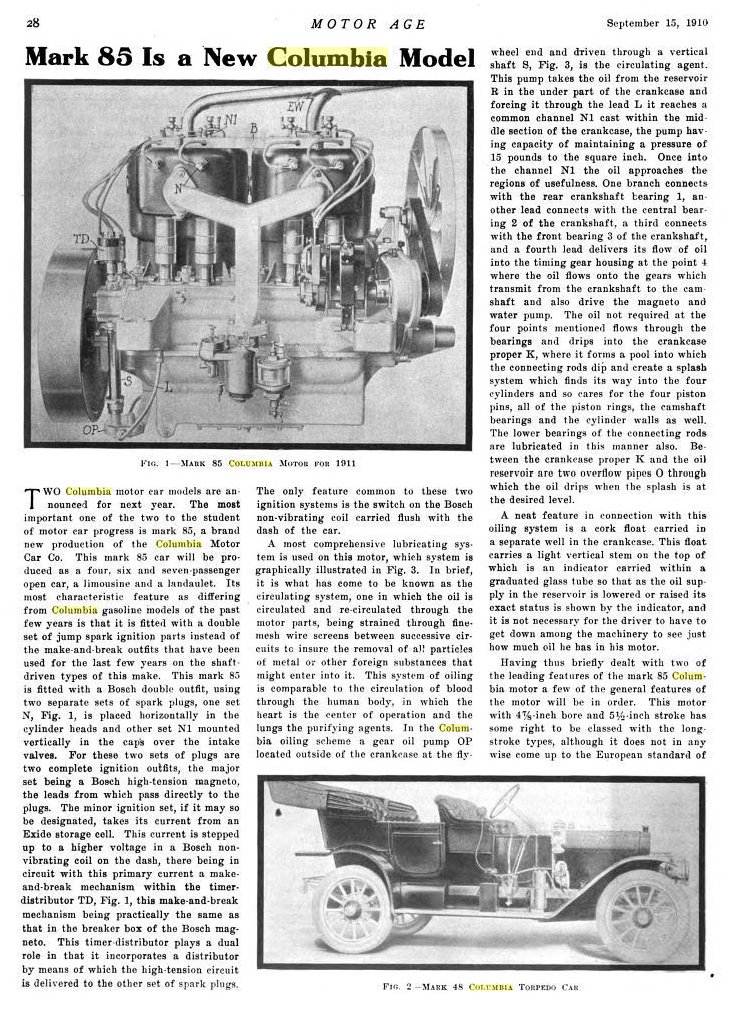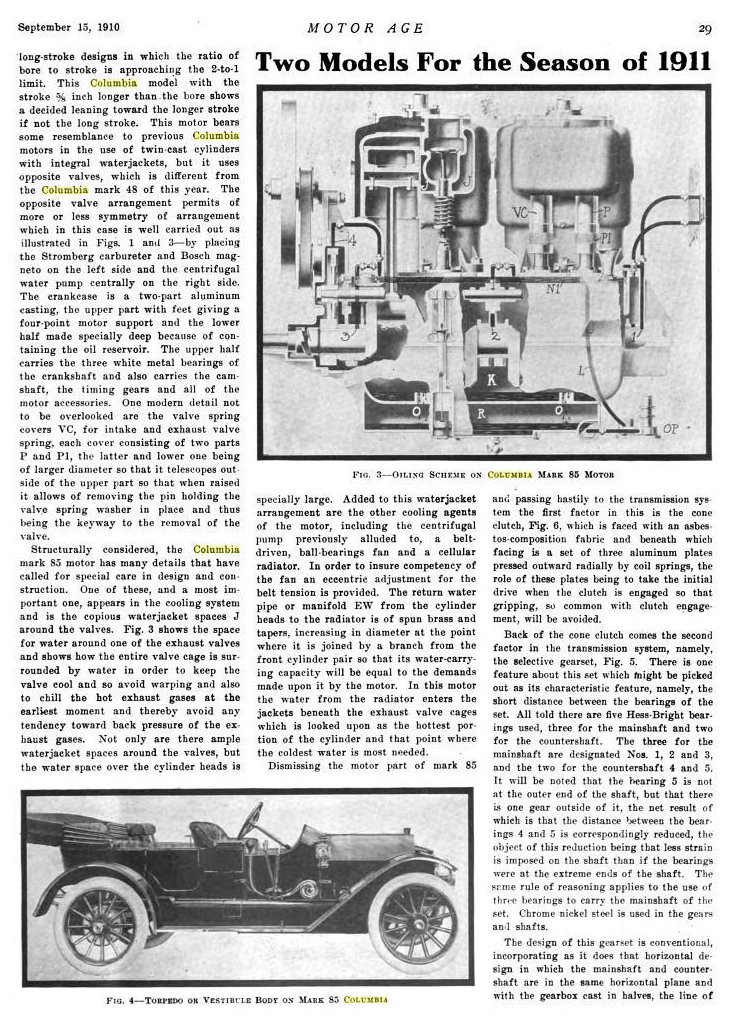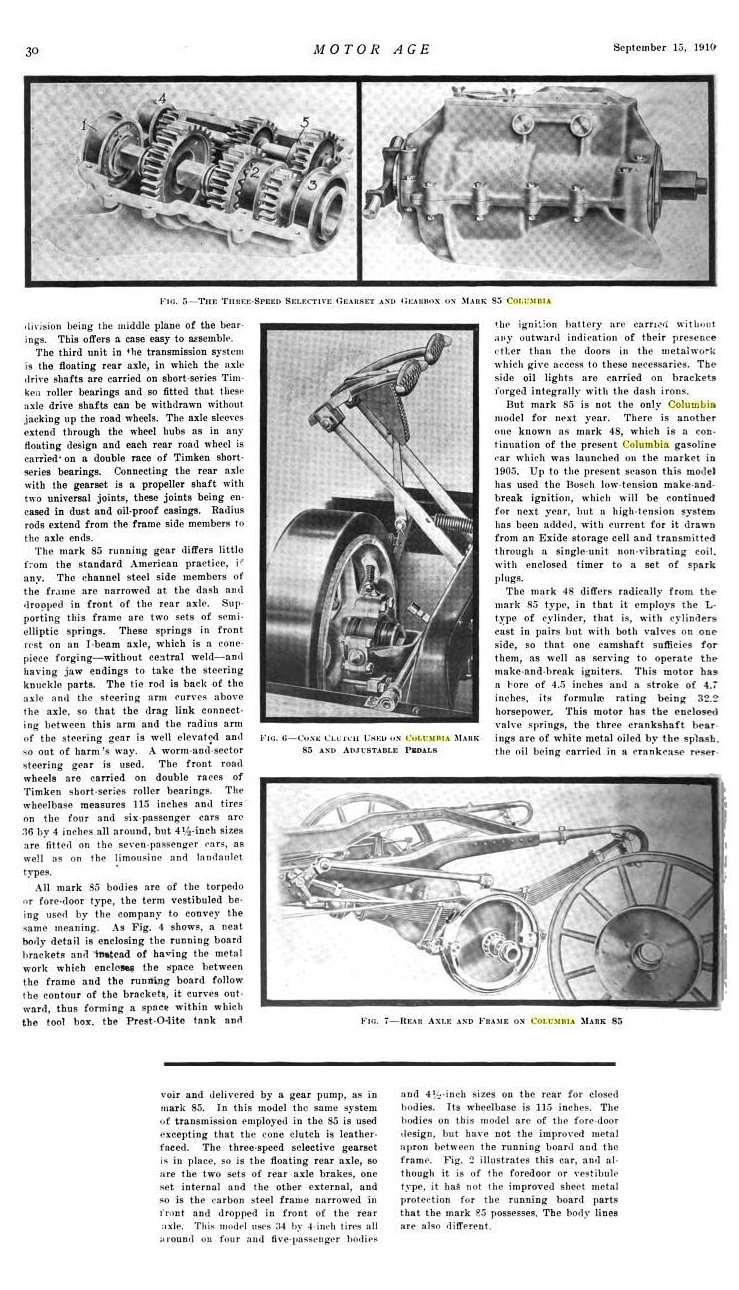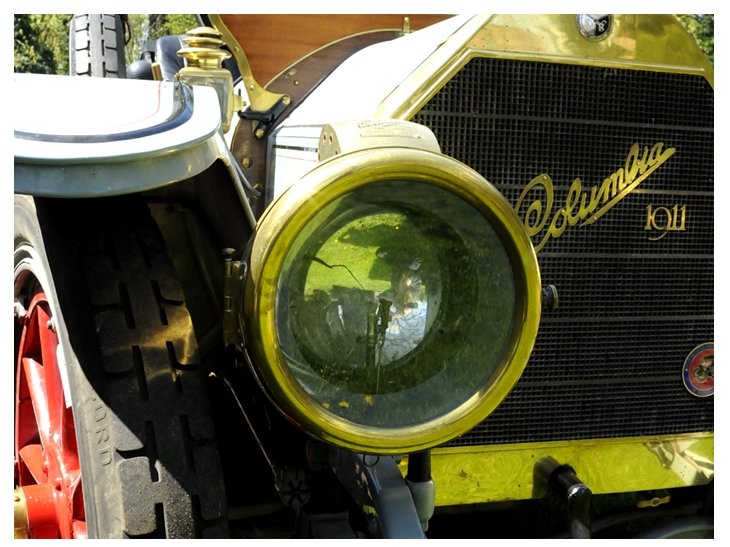|
1911 Columbia Mark 85
Story and photos by Jerry
F. Boone
[From PopularRestorations.com] 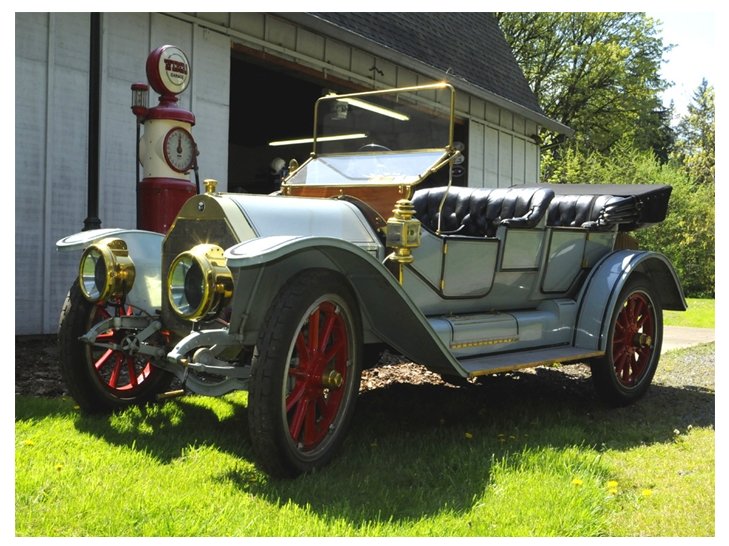 Steve Weber remembers when the mighty Columbia rolled from coast to coast. It was in 1985 when he and his wife backed the Columbia’s rear wheels into the Atlantic Ocean at Portland, Maine and pointed the antique car west. After nearly 4,000 miles and more than a month on the road, the car arrived at Portland’s West Coast namesake city, and then steered for a quick dip in the Pacific. And that’s when trouble hit. “It got stuck,” says Weber with a laugh. “It was really about the only problem we had during the entire trip. It took a few extra people to push it out of the sand.” Today the 1911 Columbia sits in Weber’s shop on the eastern edge of Oregon City, where it is surrounded by other vintage parts and cars. It is one of only two 1911s known to exist, he says. Weber bought it in 1975 because he was looking for a vintage hot rod. “My wife and I wanted to do some long tours with antique car clubs,” he says. “Everything I owned to that point was really too slow for the job.” 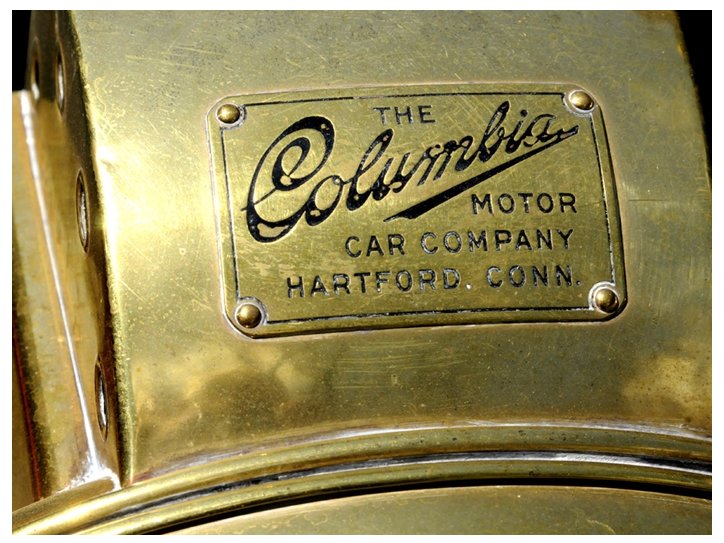 The Columbia, in contrast, was high speed luxury. Weber says that back in 1911, the car cost about $3,500. “For half that amount of money you could buy a huge lot and have a house built on it,” he says. “A car like this was really a major investment.” 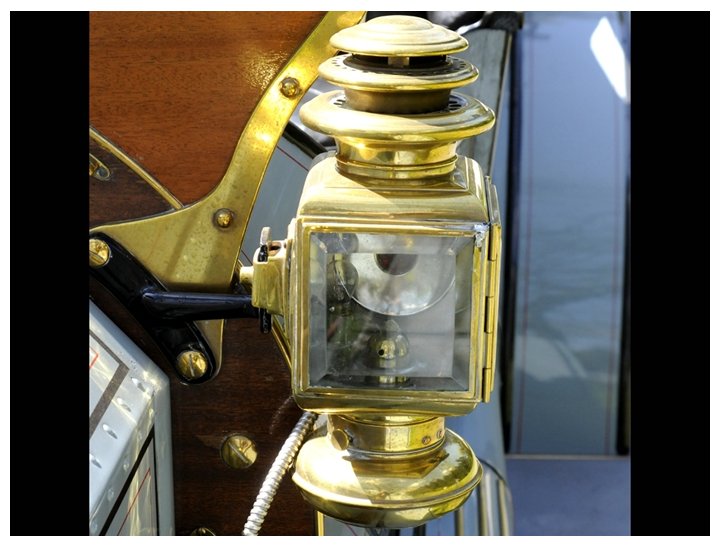 Today it is a timeless classic, with flowing lines, a massive radiator topped with gleaming brass, cut glass lanterns and soft leather upholstery. 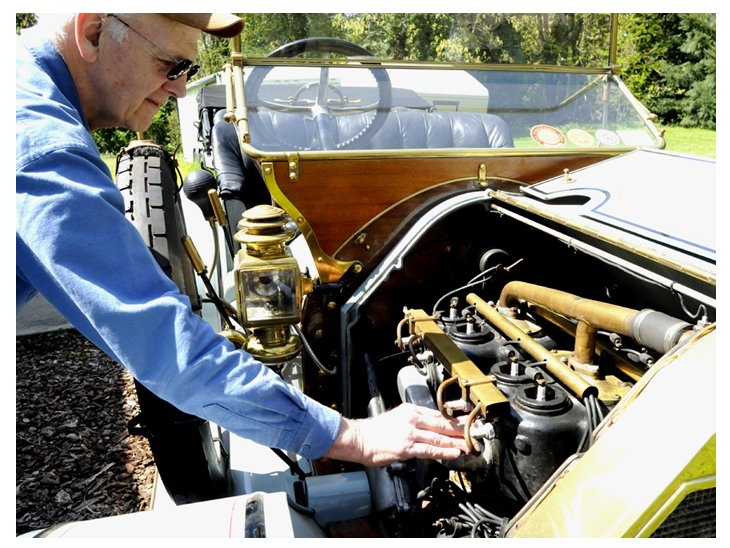 Weber opens the hood to reveal a massive 430 cubic inch four-cylinder engine, equipped with multiple spark plugs for each cylinder. “The pistons are so large that the best way to get the fuel to fully combust is to fire multiple spark plugs,” he says. And just getting them to fire is a bit of an operation. Weber opens a valve to begin the fuel flow. “There is no choke, so you just let the gas run until it makes a puddle on the floor,” he says. “It kind of floods everything.” He pulls hard on the crank to get everything working together, and switches on the ignition. With one more yank on the handle, the engine chugs to life and settles down to an erratic idle. “It doesn’t run well ‘til it gets warmed up,” he says, “and all that cast iron takes a while to warm up.” On the road, the car glides down the smooth pavement, the engine turning almost lazily in front of the polished wood dashboard. People on sidewalk stop and wave or fumble for cell phone cameras to get a picture of the piece of rolling history. Everyone who sees it grins and waves.
In spite of the skinny wheels (think of a 4,000-pound car riding on four tires the size of motorcycle treads) and high seating position, the Columbia is surprisingly stable around the curves. “It can be a handful on bad roads,” Weber says as he works it around potholes on the street leading to his house, “but out on the highway, it is a lot of fun.” He says is will easily hit 70 on the open road, which was part of the car’s appeal. “I’m a hot rodder at heart,” says. That’s a bit of an understatement. He cut his teeth drag racing and then went on to set land speed records at the Bonneville Salt Flats. Weber loves working on the machinery. His shop and garage are filled with projects he’s taking apart, putting together or just thinking about. He’s a retired machinist and tool maker, so there isn’t much he can’t build himself. He eases the car down the long driveway, past the picket fence and the large garden to the shop decorated with vintage posters and an old-fashioned gas pump. Does he ever worry about taking an almost irreplaceable piece of automotive history out on the open road? “If you don’t use it,” he says while the engine snaps and
crackles as it cools, “there’s no sense having it.”
=== ===
=== === ===
The following article is from Automotive
Industries magazine, Volume 23, September 1, 1910.
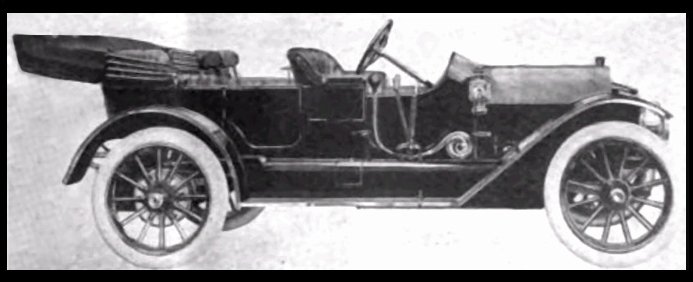 Columbia Is Ready MARK 85 IS THE LATEST FROM THIS PLANT; VESTIBULE TYPE OF BODY IS A DISTINGUISHING FEATURE; ALL MODELS REFINED AND AMPLIFIED In connection with the announcement of its 1911 models it is interesting to note that the Columbia Motor Car Company has incorporated therein not a few refinements and several novel features as has been its custom in each of the sixteen years it has been engaged in the building of automobiles. For the coming season two gasoline cars are announced. The well-known Mark 48, which first saw the light in 1905, is continued, with some refinements and a few changes, but will be known as “Mark 48, Lot 5.” In addition there will be a new model, denominated as “Mark 85.” It is with the latter that this article will more particularly deal. ... All of the bodies are of metal, reinforced with wood, and all open bodies are trimmed with the best quality of hand-buffed leather with curled hair and coil spring upholstery, there being a wide choice allowed purchasers in upholstering and trimming of coach bodies. ... The motor or the Mark 85 develops 35 horsepower, A.L.A.M. rating*, and the wheelbase is 120 inches--the tread* being 56 inches, with a road clearance of 11 inches. ... The motor is of the four cylinder “T-head” type, with cylinders cast in pairs having a bore of 4 7/8 inches an stroke 5 1/2 inches. The water jackets are cast integral with the cylinders. The valves being on opposite sides of the motor, with large water circulation areas around the valve seats and valve stems. The design of the cylinders includes a polished plate top, which may be removed for inspection. The ignition is the new Bosch double system, using eight plugs. There is a independent battery system and an independent magneto system. One or the other, or both systems in common may be used. In no way is this to be confounded the previous Bosch dual system with two sources of supply and a single scheme of distribution. The new Bosch double system includes two absolutely independent source of current and means of distribution. The two systems are controlled from a single switch mounted upon the dash, which switch is operated by hand or foot, and a rotating barrel with stops for battery or magneto contacts of at a midway stop when all eight plugs are used in firing. The switch handle is fitted with a locking device and the switch cannot be removed from the “off” position without the key properly inserted in the switch handle. This feature will make the tampering with or unwarranted use of cars difficult of accomplishing if not absolutely impossible. ... The transmission is similar to those used in Columbia cars since 1903. In this transmission there is a very short length of shift left unsupported. Both the main and the secondary shafts are equipped with Hess-Bright ball bearings. Operation is through a selective grid iron gate by a single lever within the driver’s reach. The Columbia price proposition is sufficiently varied to
appeal to
all classes of buyers: Mark 85, four-passenger roadster, $3,300;
six-passenger roadster, $3,400; seven-passenger touring, $3,500; seven
passenger limousine, $4,800; seven passenger landaulet, $4,900. Mark
48, Lot 5, five-passenger touring, $2750; four-passenger roadster
(vestibuled body), $2750. ---------- *A.L.A.M. horsepower was a formula-based horsepower rating used by automobile manufacturers. The formula was specified by the Association of Licensed Automobile Manufacturers: the square of the bore (in inches) time the number of cylinders, divided by 2.5. **The “tread,” is presumably the “track width” which is the
distance
between the center line of the left wheel to the center line of the
right wheel. |
